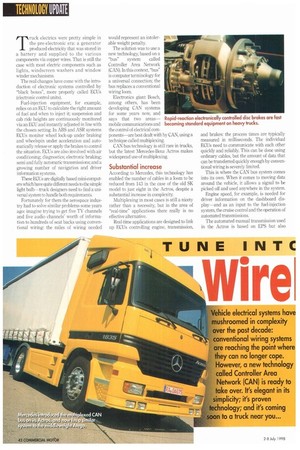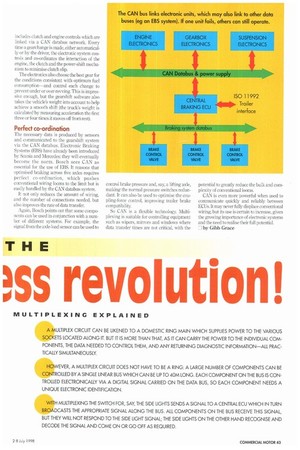Vehicle electrical systems have mushroomed in complexity over the past
Page 44

Page 45

If you've noticed an error in this article please click here to report it so we can fix it.
decade: conventional wiring systems are reaching the point where they can no longer cope.
However, a new technology called Controller Area Network {CAN) is ready to take over. It's elegant in its simplicity; it's proven
-„ technology; and it's coming i, soon to a truck near you... Truck electrics were pretty simple in the pre-electronic era: a generator produced electricity that was stored in a battery and supplied to the various components via copper wires. That is still the case with most electric components such as lights, windscreen washers and window winder mechanisms.
The real changes have come with the introduction of electronic systems controlled by "black boxes", more properly called ECUs (electronic control units).
Fuel-injection equipment, for example, relies on an ECU to calculate the right amount of fuel and when to inject it; suspension and cab ride heights are continuously monitored via an ECU and instantly adjusted in line with the chosen setting. In ABS and ASR systems ECUs monitor wheel lock-up under braking and wheelspin under acceleration and automatically release or apply the brakes to control the situation. ECUs are also involved with air conditioning; diagnostics; electronic braking; semi and fully automatic transmissions; and a growing number of navigation and driver information systems.
These ECUs are digitally based mini-computers which have quite different needs to the simple light bulb—truck designers need to find a universal system to handle both requirement& Fortunately for them the aerospace industry had to solve similar problems some years ago: imagine trying to get five TV channels and five audio channels' worth of information to hundreds of seat backs using conventional wiring: the miles of wiring needed would represent an intolerable weight penalty.
The solution was to use a new technology, based on a "bus" system called Controller Area Network (CAN). In this context, "bus" is computer terminology for a universal connection; the bus replaces a conventional wiring loom.
Electronics giant Bosch, among others, has been developing CAN systems for some years now, and says that two areas— mobile communications and the control of electrical components—are best dealt with by CAN, using a technique called multiplexing. CAN bus technology is still rare in trucks, but the latest Mercedes-Benz Actros makes widespread use of multiplexing.
Substantial increase
According to Mercedes, this technology has enabled the number of cables in a loom to be reduced from 143 in the case of the old SK model to just eight in the Actros, despite a substantial increase in complexity.
Multiplexing in most cases is still a nicety rather than a necessity, but in the area of "real-time" applications there really is no effective alternative.
Real-time applications are designed to link up ECUs controlling engine, transmission, and brakes: the process times are typically measured in milliseconds. The individual ECUs need to communicate with each other quickly and reliably. This can be done using ordinary cables, but the amount of data that can be transferred quickly enough by conventional wiring is severely limited.
This is where the CAN bus system comes into its own. When it comes to moving data around the vehicle, it allows a signal to be picked off and used anywhere in the system.
Engine speed, for example, is needed for driver information on the dashboard display—and as an input to the fuel-injection system, the cruise control and the operation of automated transmissions.
The automated manual transmission used in the Actros is based on EPS but also includes clutch and engine controls which are linked via a CAN databus network. Every time a gearchange is made, either automatically or by the driver, the electronic system controls and co-ordinates the interaction of the engine, the clutch and the power-shift mechanism to minimise clutch slip.
The electronics also choose the best gear for the conditions consistent with optimum fuel consumption—and control each change to prevent under or over-revving. This is impressive enough, but the gearshift software also takes the vehicle's weight into account to help achieve a smooth shift (the truck's weight is calculated by measuring acceleration the first three or four times it moves off froth rest).
Perfect co-ordination
The necessary data is produced by sensors and communicated to the gearshift system via the CAN databus. Electronic Braking Systems (EBS) have already been introduced by Scania and Mercedes; they will eventually become the norm. Bosch sees CAN as essential for the use of EBS. It reasons that optimised braking across five axles requires perfect co-ordination, which pushes conventional wiring looms to the limit but is easily handled by the CAN databus system.
It not only reduces the amount of wiring, and the number of connections needed, but also improves the rate of data transfer.
Again. Bosch points out that some components can be used in conjunction with a number of different systems. For example, the signal from the axle-load sensor can be used to control brake pressure and, say, a lifting axle, making the normal pressure switches redundant. It can also be used to optimise the coupling-force control, improving trailer brake compatibility So CAN is a flexible technology. Multiplexing is suitable for controlling equipment such as wipers, mirrors and windows where data transfer times are not critical, with the potential to greatly reduce the bulk and complexity of conventional looms.
CAN is even more powerful when used to communicate quickly and reliably between ECUs. It may never fully displace conventional wiring, but its use is certain to increase, given the growing importance of electronic systems and the need to realise their full potential.
71 by Gibb Grace
MULTIPLEXING EXPLAINED
A MULTIPLEX CIRCUIT CAN BE LIKENED TO A DOMESTIC RING MAIN WHICH SUPPLIES POWER TO THE VARIOUS SOCKETS LOCATED ALONG IT. BUT IT IS MORE THAN THAT, AS IT CAN CARRY THE POWER TO THE INDIVIDUAL COMPONENTS, THE DATA NEEDED TO CONTROL THEM, AND ANY RETURNING DIAGNOSTIC INFORMATION—ALL PRACTICALLY SIMULTANEOUSLY.
HOWEVER, A MULTIPLEX CIRCUIT DOES NOT HAVE TO BE A RING: A LARGE NUMBER OF COMPONENTS CAN BE CONTROLLED BY A SINGLE LINEAR BUS WHICH CAN BE UP TO 40M LONG. EACH COMPONENT ON THE BUS IS CONTROLLED ELECTRONICALLY VIA A DIGITAL SIGNAL CARRIED ON THE DATA BUS, SO EACH COMPONENT NEEDS A UNIQUE ELECTRONIC IDENTIFICATION.
WITH MULTIPLEXING THE SWITCH FOR, SAY, THE SIDE LIGHTS SENDS A SIGNAL TO A CENTRAL ECU WHICH IN TURN BROADCASTS THE APPROPRIATE SIGNAL ALONG THE BUS. ALL COMPONENTS ON THE BUS RECEIVE THIS SIGNAL, BUT THEY WILL NOT RESPOND TO THE SIDE LIGHT SIGNAL; THE SIDE LIGHTS ON THE OTHER HAND RECOGNISE AND DECODE THE SIGNAL AND COME ON OR GO OFF AS REQUIRED.












































































































